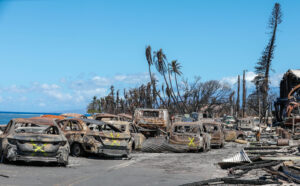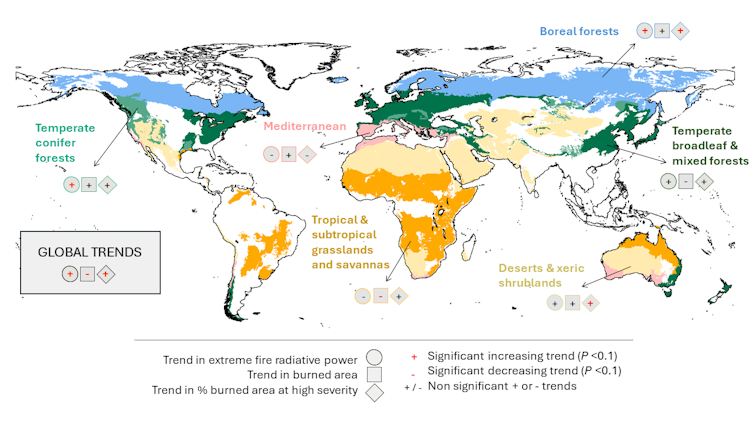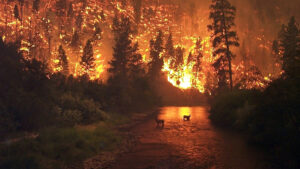By Víctor Fernández García, Université de Lausanne, and Cristina Santín, Swansea University
It feels like we are getting used to the Earth being on fire. Recently, more than 70 wildfires burned simultaneously in Greece. In early 2024, Chile suffered its worst wildfire season in history, with more than 130 people killed. Last year, Canada’s record-breaking wildfires burned from March to November and, in August, flames devastated the island of Maui, in Hawaii. And the list goes on and on.

Watching the news, it certainly feels like catastrophic extreme wildfires are happening more often, and unfortunately this feeling has now been confirmed as correct. A new study published in Nature Ecology & Evolution shows that the number and intensity of the most extreme wildfires on Earth have doubled over the past two decades.
The authors of the new study, researchers at the University of Tasmania, first calculated the energy released by different fires over 21 years from 2003 to 2023. They did this by using a satellite-based sensor which can identify heat from fires, measuring the energy released as “fire radiative power”.
The researchers identified a total of 30 million fires (technically 30 million “fire events”, which can include some clusters of fires grouped together). They then selected the top 2,913 with the most energy released, that is, the 0.01% “most extreme” wildfires. Their work shows that these extreme wildfires are becoming more frequent, with their number doubling over the past two decades. Since 2017, the Earth has experienced the six years with the highest number of extreme wildfires (all years except 2022).
Importantly, these extreme wildfires are also becoming even more intense. Those classified as extreme in recent years released twice the energy of those classified as extreme at the start of the studied period.
These findings align with other recent evidence that wildfires are worsening. For instance, the area of forest burned every year is slightly increasing, leading to a corresponding rise in forest carbon emissions. (The total land area burned each year is actually decreasing, due to a decrease in grassland and cropland fires, but these fires are lower intensity and emit less carbon than forest fires).
Burn severity – an indicator of how badly a fire damages the ecosystem – is also worsening in many regions, and the percentage of burned land affected by high severity burning is increasing globally as well.

(Victor Fernandez Garcia, Data: Cunningham et al, Nature Eco; Fernandez-Garcia & Alonso-Gonzales, Remote Sensing, 2023)
Although the global outlook is overall not good, there are striking differences among regions. The new study identifies boreal forests of the far north and temperate conifer forests (blue and light green in the above map) as the critical types of ecosystem driving the global increase in extreme wildfires. They have the higher number of extreme fires relative to their extent, and show the most dramatic worsening over time, while also seeing an increase in total burned area and percentage burned at high severity. The confluence of these three trends is particularly pervasive in eastern Siberia, and the western US and Canada.
What turns a fire into a catastrophe

Nonetheless, many other regions are also susceptible to fires becoming more consequential, as what turns a fire into a catastrophe depends not only on fire trends but also on the environmental, social and economic context.
For instance, in temperate broadleaf forests around the Mediterranean, there has not been a big change in fire activity and behavior. But the growing number of houses built in and around wild vegetation in fire-prone areas is a clear example of an action that increases human risk and can lead to catastrophe.
The doubling in extreme wildfires adds to a complex picture of fire patterns and trends. This new evidence underscores the urgency of addressing the root causes behind worsening wildfire activity, such as land cover changes, forest policies and management, and, of course, climate change. This will better prepare us for these extreme fires, which are near-impossible to combat using traditional firefighting methods.![]()
Víctor Fernández García is a researcher at the University of Lausanne and Cristina Santín is an honorary associate professor of biosciences at Swansea University.
This article is republished from The Conversation under a Creative Commons license. Read the original article.
Sign up for The Invading Sea newsletter by visiting here. If you are interested in submitting an opinion piece to The Invading Sea, email Editor Nathan Crabbe at ncrabbe@fau.edu.



